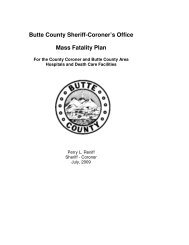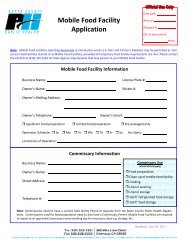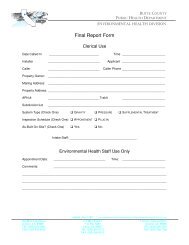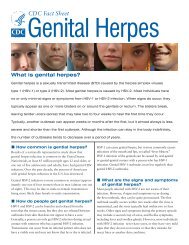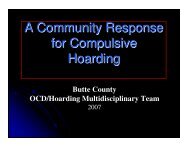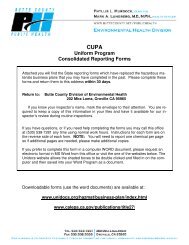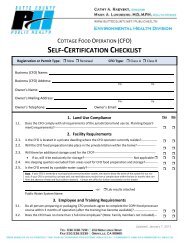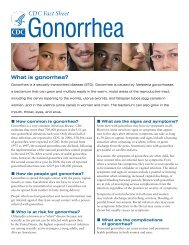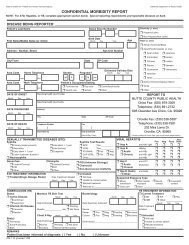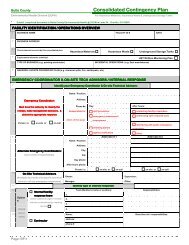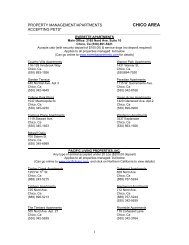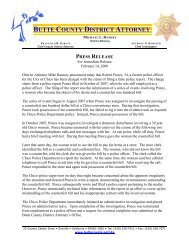Mobile Food Facility Informational Packet - Butte County
Mobile Food Facility Informational Packet - Butte County
Mobile Food Facility Informational Packet - Butte County
You also want an ePaper? Increase the reach of your titles
YUMPU automatically turns print PDFs into web optimized ePapers that Google loves.
<strong>Mobile</strong> <strong>Food</strong> <strong>Facility</strong><strong>Informational</strong> <strong>Packet</strong>INTRODUCTION<strong>Mobile</strong> <strong>Food</strong> Facilities are a valuable resourcefor the community. They make a varietyof tasty food conveniently available tothe public. The Public Health Departmentwants to partner with <strong>Mobile</strong> <strong>Food</strong> Facilitiesto assure that the public is always servedfresh and safe food from mobile carts andvehicles.This informational packet has two parts.Part One describes requirements for <strong>Mobile</strong><strong>Food</strong> Facilities. Part Two provides usefulinformation for understanding some of therequirements and concepts referenced inPart One. When this is the case, referenceto Part Two is indicated by the symbol .Plan Check and Initial InspectionCalifornia Retail <strong>Food</strong> Code has specific requirementsfor the construction of <strong>Mobile</strong> <strong>Food</strong> Facilities,based on the type of food to be served andhow it will be prepared and served at the facility.Therefore, our Environmental Health staff will assistyou to assure the type and design of the mobilefacility you choose will be appropriate andadequately designed for your intended use.In addition to meeting California Retail <strong>Food</strong> Codestandards, most <strong>Mobile</strong> <strong>Food</strong> Facilities must meetthe California Department of Housing and CommunityDevelopment standards. That agency maybe contacted at by telephone at (919)-255-2501.PART ONE. REQUIREMENTSRevised September 20, 2011
<strong>Mobile</strong> <strong>Food</strong> <strong>Facility</strong> <strong>Informational</strong> <strong>Packet</strong>Page 2Identification of <strong>Mobile</strong> <strong>Food</strong> <strong>Facility</strong> Category<strong>Mobile</strong> <strong>Food</strong> Facilities fall into one of three different categories. The selection of category is based onthe type of food served and how the food is prepared. Types of food that have a higher risk of causingfoodborne illness and preparation practices that involve more handling of food have more extensivefood safety requirements. This informational packet will frequently refer to Potentially Hazardous <strong>Food</strong>.These are foods that support bacterial growth and can cause foodborne illness.Some foods, such as meats and dairy products are readily recognized by most people as “potentiallyhazardous.” Other foods, such as cut melons and cooked grains or vegetables are not so readily recognizedas “potentially hazardous.” 1Because our food safety requirements for <strong>Mobile</strong> <strong>Food</strong> Facilities are based on the category of facility, itis important for you to know your facility’s category. Environmental Health staff will assist you in makingthis determination. The quick reference guide on the following page will also assist in this determination.Quick Reference Guide for Determining <strong>Facility</strong> Category<strong>Food</strong> Type or Process Description Taking Place at <strong>Mobile</strong> <strong>Facility</strong>Category1 2 3Pre-packaged food • • •Whole seafood • • •Raw produce • • •Non-potentially hazardous beverage from approved bulk dispensing units • • •Limited preparation 2 on <strong>Mobile</strong> <strong>Food</strong> <strong>Facility</strong> • •Steaming or boiling hot dogs • •Preparing PHF or ingredients of PHF•Examples of different <strong>Mobile</strong> <strong>Food</strong> Facilities in categoriesCarts with candy bar and canned or bottled beverages•Carts with pre-packaged frozen ice cream products•Carts with pre-packed salads and sandwiches•Carts with shaved ice•Hot dog cart•Popcorn cart•Tamale cart (with Tamales in their original, inedible wrapper)•Coffee and Espresso cart•Taco trucks•1Additional explanation provided in Part Two of this <strong>Informational</strong> <strong>Packet</strong>2 Limited food preparation may include heating, frying, baking, roasting, popping, shaving of ice, blending, steaming or boilingof hot dogs, or assembly of non-prepackaged food. Limited food preparation does NOT include handling practices such asslicing or chopping (except on heated cooking surface), grinding, thawing, reheating potentially hazardous food for hot holding,hot holding of non-prepackaged potentially hazardous food, or cooking for later useRevised September 20, 2011
<strong>Mobile</strong> <strong>Food</strong> <strong>Facility</strong> <strong>Informational</strong> <strong>Packet</strong>Page 3Requirements Based on <strong>Facility</strong> CategoryThe following table summarizes the facility, equipment, operational, food worker hygiene, and safetyrequirements for each of the three categories of <strong>Mobile</strong> <strong>Food</strong> Facilities. Detailed, complete requirementsare found in the California Retail <strong>Food</strong> Code that can be accessed on the Environmental Healthwebpage (see last page of this packet for the web address).<strong>Food</strong> Safety Requirements Based on <strong>Facility</strong> Category<strong>Food</strong> Safety RequirementCategory1 2 3<strong>Facility</strong> RequirementsPermit to Operate from <strong>Butte</strong> <strong>County</strong> Environmental Health • • •<strong>Facility</strong> name clearly identified and labeled 1 • • •<strong>Facility</strong> constructed so as to be easily cleanable with smooth non-absorbent surfacesin good repair• • •<strong>Facility</strong> located within 200 feet of available toilet and hand washing facilities • • •Adequate preparation/counter space • • •Approved mechanical exhaust ventilation over all cooking equipment 2 • •One compartment hand washing sink 3 • •Overhead protection for areas of food preparation, storage, and display (includingfood compartments)• •Hot water heater able to provide at least 1 gallon per minute and at least ½ gallon ofwater 100-104 0 F for hand washing sink•Hot water heater minimum of 3 gallons or equivalent instantaneous heater able toprovide adequate amount of water at 120 0 F for utensil washing 4 •Utensil sink meeting following requirements: 4 Constructed of stainless steel with three compartments 5• Dual integral drain boards• Sink is either integral to the unit or, for unenclosed Category 2 facilities wherea utensil sink is required, the sink may be located in an adjacent auxiliary unit•owned and operated by mobile facility ownerFresh water tank requirements: Minimum of 5 gal. reserved for hand washing • •1 Include business name, city, state, zip, name of permit holder if different than business name on both sides of vehicle exterior;business name inat least 3 in high letters and other information in at least 1 in. high letters2 Must meet the current Uniform Mechanical Code and have been tested and approved by an official hood testing agency andcomply with the testing agency’s conditions of approval3 Sink must be at least 9 in. x 9 in. x 5 in. deep, separated from utensil sink (if provided) by 2 ft. or 6 in. splash guard4 Note: Some Category 2 <strong>Mobile</strong> <strong>Food</strong> Facilities may need a utensil sink, based on the type of food prepared and method ofpreparation. Contact our office to make this determination5 Each compartment needs to be at least 12 in. x 12 in. x 10 in. deep, or 10 in. x 14 in. x 10 in. deep and large enough for largestutensilRevised September 20, 2011
<strong>Mobile</strong> <strong>Food</strong> <strong>Facility</strong> <strong>Informational</strong> <strong>Packet</strong>Page 4<strong>Food</strong> Safety RequirementCategory1 2 3 20 gal. minimum capacity (of which 5 gal. is reserved for hand washing) ifutensil washing is required at the mobile facility• 30 gal. minimum capacity (of which 5 gal. is reserved for hand washing)• Protected inlet ¾ in. or less, located above tank overflow and constructed toprevent its use for any other purpose• • Drain outlet allowing the tank to be completely emptied • • Access port provided where possible • • Properly vented • • Mounted to the <strong>Mobile</strong> <strong>Food</strong> <strong>Facility</strong> • •Wastewater tank requirements: Wastewater tank at least 50% larger than fresh water tank • • Additional 33% storage capacity for ice bin 1 • • Additional 15% storage capacity for beverage dispenser • •Full facility enclosure required•Minimum requirements for fully enclosed facilities: 2 <strong>Facility</strong> approved by CA Dept. of Housing and Community Development HCDcontact telephone number: (919)-255-2501• Easily cleanable walls, floors, and ceilings• Minimum aisle height 74 inches and width 30 inches• Floors non-slip and with coving• Service windows 216 sq. in. or less and spaced at least 18 in. apart•Equipment RequirementsAdequate refrigeration for type and process of food preparation, storage, and display • • •Equipment in compliance with ANSI approved standard (i.e. NSF) • • •Equipment and utensils easily cleanable • • •Equipment located and spaced to be easily cleanable • • •Single-service utensils individually wrapped or dispensed in sanitary manner • • •Utensils handled and stored so as to be protected from contamination • •Adequate commercial-grade storage refrigerator (if potentially hazardous food iscooked and cooled)•Operational RequirementsReport to an approved Commissary each operating day • • •<strong>Food</strong> at end of day stored in Commissary, EXCEPT potentially hazardous food, held ordisplayed hot, not re-served to public after operating day• • •<strong>Food</strong> from an approved source, such as a commercial wholesale or retail facility • • •No food prepared or stored in private home • • •1 Category One facilities with ice bin but no fresh water tank need to have a waste water tank equal to one-third the volumeof the ice bin2 Requirements for fully enclosed facilities also apply to Category One and Two facilities that are fully enclosed.Revised September 20, 2011
<strong>Mobile</strong> <strong>Food</strong> <strong>Facility</strong> <strong>Informational</strong> <strong>Packet</strong>Page 5<strong>Food</strong> Safety RequirementCategory1 2 3No smoking in the facility • • •<strong>Food</strong> protected from contamination during storage, transportation, and operation • • •Potentially hazardous food maintained at/ below 41 0 F or at/above 135 0 F 1 • • •<strong>Food</strong> protected from cross-contamination • • •<strong>Food</strong> properly labeled • • •Chemical storage away from food and food preparation or storage areas. Poisonouschemicals plainly labeled in original container in separate enclosure.• • •<strong>Food</strong> condiments prepackaged or in approved dispenser when offered self-service • • •No food stored or served outside facility during operation other than packaged nonpotentiallyhazardous food at Farmer’s Market or Community Event• • •<strong>Food</strong> contact surfaces protected from contamination during storage, transportation,and operation• • •Trash collected and liquid waste drained into approved waste receptors • • •Operator of unenclosed facility has written operating procedures for food handlingand cleaning and sanitizing equipment and food contact surfaces•Potentially hazardous food cooked to proper temperature • •Unpackaged food handled in fully enclosed facility or within approved food compartmentshaving tight fitting closure• •Cleanser and single service towels in dispenser at hand washing sink • •<strong>Food</strong> Worker Requirements<strong>Food</strong> Manager and <strong>Food</strong> Handler Certification (see explanation in following section) • • •<strong>Food</strong> workers clothes clean • • •Proper hand washing techniques used by food workers • •Safety RequirementsFirst aid kit • • •All equipment and utensils tightly covered and secured if facility operates at morethan one location in day• • •Light bulbs and tubes completely enclosed in plastic safety shield • • •Second means of exit (if facility occupied), easily openable by hand, labeled “SafetyExit,” and at least 2 ft. x 3 ft.• •Minimum 10BC 3 fire extinguisher provided for heating and cooking equipment • •Gas fired appliances insulated to prevent injury and heat build up • •Additional explanation provided in Part Two of this <strong>Informational</strong> <strong>Packet</strong>2 An additional food compartment is not required when adding ingredients to a beverage or dispensing into a serving containerwhen the beverage is prepared for immediate service in response to an individual consumer order.3 Fire extinguishing capacity is rated in accordance with ANSI/UL 711: Rating and Fire Testing of Fire Extinguishers. The ratingsare described using numbers preceding the class letter. The number preceding the B indicates the size of fire in square feetthat an ordinary user should be able to extinguish. The letter C indicates that the extinguishing agent will not conduct electricity.Revised September 20, 2011
<strong>Mobile</strong> <strong>Food</strong> <strong>Facility</strong> <strong>Informational</strong> <strong>Packet</strong>Page 6Commissary Requirements<strong>Mobile</strong> <strong>Food</strong> Facilities need to have a home base for overnight security, cleaning, restocking, storage offood, etc. Commissaries need to be approved by our office to assure they will adequately meet theneeds of the mobile facility.Commissaries for Category 1 <strong>Mobile</strong> <strong>Food</strong> Facilitiesthat purchase all their pre-packagedfood from a licensed retail or wholesale foodfacility need to be approved by our office toassure overnight security and periodic cleaning.It is the responsibility of the mobile facilityowner and operator to assure that the Commissarylocation meets local zoning requirements.Commissaries for Category 1 <strong>Mobile</strong> <strong>Food</strong> Facilitiesthat process or prepare food at theCommissary, and all Category 2 <strong>Mobile</strong> <strong>Food</strong>Facilities, need a Commissary located at acommercial or semi-commercial kitchen or at a retail food facility permitted by our office. If potentiallyhazardous food is prepared in a Commissary, the Commissary must have a Commissary Permit from ouroffice.Commissaries for Category 3 <strong>Mobile</strong> <strong>Food</strong> Facilities need to be retail food facilities under permit by ouroffice. <strong>Mobile</strong> facilities in this category must also obtain a Commissary Permit from our office so that wecan make sure that the facility is adequate for the needs of the Category 3 <strong>Mobile</strong> <strong>Food</strong> <strong>Facility</strong> 1 .<strong>Food</strong> Manager Certification and <strong>Food</strong> Handler Card Requirements<strong>Mobile</strong> <strong>Food</strong> Facilities need to be run by personnel who have a sound knowledge of food safety principlesand practices. <strong>Food</strong> Manager Certification and <strong>Food</strong> Handler Cards are two ways to help assure thatpersonnel have this knowledge.<strong>Food</strong> Handler Cards (or <strong>Food</strong> Manager Certification as an alternative) is needed by all personnel of Category1, 2, and 3 <strong>Mobile</strong> <strong>Food</strong> Facilities who prepare, package, or serve food. 2 In addition, whenever potentiallyhazardous food is prepared at a Commissary or at the mobile facility, at least one person involvedin the operation needs to have <strong>Food</strong> Manager Certification.1 Exception: A Commissary Permit is NOT required when the owner/operator of the retail food facility is also the owner/operatorof the <strong>Mobile</strong> <strong>Food</strong> <strong>Facility</strong>.2 Note: This requirement does not apply to personnel of Category 1 facilities that only serve commercially pre-packaged foodobtained from licensed wholesale or retail providers.Revised September 20, 2011
<strong>Mobile</strong> <strong>Food</strong> <strong>Facility</strong> <strong>Informational</strong> <strong>Packet</strong>Page 7PART TWO. ADDITIONAL INFORMATIONWhat is Potentially Hazardous <strong>Food</strong>?Potentially Hazardous <strong>Food</strong> is a term used by food safety organizationsto classify foods that require time-temperaturecontrol to keep them safe for human consumption.DefinitionA potentially hazardous food means food that requires timeor temperature control to limit the growth of microorganismsthat can make people sick.Some foods are widely known as potentially hazardous. Othersare not so obvious but have been shown to be potentiallyhazardous by recent foodborne disease outbreaks.Examples of Potentially Hazardous <strong>Food</strong>sThe US <strong>Food</strong> and Drug Administration <strong>Food</strong> Code identifiesthe following examples of potentially hazardous foods:Meat (beef, pork, lamb)Poultry (chicken, turkey, duck)Fish, shellfish, and crustaceansEggs (except those treated to eliminate Salmonella)Milk and dairy productsHeat-treated plant food (cooked rice, beans, or vegetables)Baked potatoesMushrooms, raw sprouts,Cut melons and tomatoesTofu and soy-protein foodsUntreated garlic and oil mixturesFactors that contribute to foodborne illness:Improper cooling of potentially hazardous foods12 or more hours between preparation and saleof potentially hazardous foodImproper holding temperature (hot or cold) ofpotentially hazardous foodPeople who are ill or infected handling foodsContaminated raw food or ingredientsCross-contamination from raw to cooked orready-to-eat foodsImproper cleaning of equipment and utensilsInadequate cookingRevised September 20, 2011
<strong>Mobile</strong> <strong>Food</strong> <strong>Facility</strong> <strong>Informational</strong> <strong>Packet</strong>Page 8Temperature ControlTemperature control of potentially hazardousfood is absolutely essential for preventingfoodborne illness. Here are the key elementsof temperature control for potentiallyhazardous food that need to be followed:‣ In order to kill any harmful bacteriapresent on raw meats, fish eggs,and poultry, thoroughly cook thesefoods to bring the internal temperatureto that which is shown in thischart‣ Always hold at or below 41°F -orator above 135°F‣ If held at or above 135°F during theday, discard the food at the end ofthe dayAdequate Control EquipmentThe equipment you use for cold holdingand hot holding potentially hazardousfoods needs to be adequate for the typeand amount of food and for the ambienttemperature where the facility is located.Potentially hazardous food held hot needs tomaintain an internal temperature at or above135°F and potentially hazardous food heldcold must be held at or below41°F.Importance of ProperThermometersTemperature control to protect food safety requires accurate thermometers and vigilanceby all those who are staffing the mobile food facility. Thermometers need to belocated in each refrigerator and hot holding unit, and a metal stem thermometer (0-220°F or digital) needs to be available for checking hot and cold food temperatures.Revised September 20, 2011
<strong>Mobile</strong> <strong>Food</strong> <strong>Facility</strong> <strong>Informational</strong> <strong>Packet</strong>Page 9Protecting <strong>Food</strong> from ContaminationCross-ContaminationCooked foods and produce need to be stored and handled separatelyfrom raw beef, pork, fish, and poultry so they do not become exposedto harmful organisms that could cause foodborne illness.Here are some helpful suggestions:‣ Wash hands frequently as described in the following section of thisResource Guide.‣ Wash utensils between uses or choose another safety option asdescribed in the section on utensil washing in this Resource Guide.‣ Use clean wiping cloths stored between uses in disinfectant solutionto wipe food contact surfaces. Avoid reusing wiping clothsthat have been used to clean up blood or juices from raw meat!Cloths reused to clean and sanitizefood contact surfaces need tobe kept in a bucket of sanitizingsolution. A common sanitizingsolution is about 1 tablespoon ofhousehold bleach per gallon ofwater.‣ Store raw meats, fish, eggsand poultry separate from produce and ready-to-eat foods. Storeraw meats, fish, eggs and poultry below produce and ready-to-eatfoods in refrigerators.Employee HealthProtection on Display<strong>Food</strong>s need to be displayed in a manmannerthat minimizes potentialcontamination from people who arewalking by or purchasing food. Insome cases, the food can be packagedor displayed in a manner thatwill minimize potential contamination andmake use of food compartments unnecessary.Discuss alternatives available with our staff.The following are the most commonorganisms that cause foodborneillness:‣ Norovirus: leading cause offoodborne illness in the UnitedStates. Found in food handledby food workers prepared withbare hands. Source is humanfeces.‣ Campylobacter jejuni: found indairy or poultry products.‣ E. coli 0157:H7: commonlyfound in undercooked beef,water, and unpasteurized juicesand ciders.‣ Salmonella: found in poultry orraw eggs.‣ Shigella: found in ready-to-eatfoods handled by ill food workers.‣ Listeria: found in raw meat,processed meats, deli meats,seafood or dairy products.‣ Yersini enterocolitica: found inundercooked pork, milk, or water.‣ Vibrio parahemolyticus: foundin seafood and shellfish.‣ Hepatitis A virus: found infoods handled by ill food workersprepared with bare hands.‣ Bacillus cereus: found inbeans, rice. and potatoes.‣ Cyclospora: found in importedfruit.<strong>Food</strong> handlers that are ill should be encouraged to stay at home and not serve food at the event, so thatthey do not pass their illness on to their customers.Revised September 20, 2011
<strong>Mobile</strong> <strong>Food</strong> <strong>Facility</strong> <strong>Informational</strong> <strong>Packet</strong>Page 10Hand Washing: Why and How?Viruses and bacteria are invisible to the naked eye,but may be present on your hands if you do not washthem thoroughly. Hand washing with soap and wateris the single most effective way to prevent the spreadof bacteria and viruses, which are the major causesof foodborne illness.Thorough hand washing (scrubbing with soap and warmwater for 20 seconds) is needed:Upon entering mobile facility and prior to foodpreparation or serviceAfter using the restroomAfter breaksAfter sneezing or coughingAfter handling raw meatsAfter handling garbage or chemicalsNote: Hand washing facilities must beseparate from utensil washing facilities forCategory 3 and Category 2 <strong>Mobile</strong> <strong>Food</strong>Facilities that involve potentially hazardousfood.Information About Hand SanitizersHand sanitizers with at least 60% alcohol have been shown to be effective in killing bacteria andsome viruses on clean hands. However, use of hand sanitizers does not replace the need for frequenthand washing by food service employees.The hands of foodworkers are often wet and may be contaminated with fatty material or with foodhigh in proteins. The presence of water, food, fatty materials, animal feces, and blood on the handscan significantly reduce the effectiveness of an alcohol-based hand sanitizer. Norovirus, the leadingcause of foodborne illness, is not killed by hand sanitizers.Revised September 20, 2011
<strong>Mobile</strong> <strong>Food</strong> <strong>Facility</strong> <strong>Informational</strong> <strong>Packet</strong>Page 11Utensil Washing Information<strong>Mobile</strong> food facilities with food preparationand reusable preparation utensilsneed to have the ability to wash, rinse,and sanitize utensils that are used to prepareand serve the food. Utensil washingfacilities should consist of a threecompartment stainless steel sink with hotand cold running water from an adequateapproved source and shall drain to aholding tank. Discuss with staff whethertaking extra utensils to be washed at theend of the day or disposable utensils forsingle-service use would be acceptablealternatives.Photo used by permission, courtesy of California CartBuilderStep 1: Wash in soapy waterStep 2: Rinse in clear waterStep 3: Soak for 60 seconds in sanitizing solutionStep 4: Air dryCONTACT INFORMATIONFor additional information about <strong>Mobile</strong> <strong>Food</strong> <strong>Facility</strong> requirements, please feel free to contact <strong>Butte</strong><strong>County</strong> Environmental Health, Consumer Protection Program:<strong>Butte</strong> <strong>County</strong> Public Health Department, Environmental Health Division202 Mira Loma Drive, Oroville CA 95965Office Telephone: (530) 538-7281Kim Haas, Senior Environmental Health Specialist: khaas@buttecounty.nethttp://www.buttecounty.net/publichealth/environmental/environmental.htmlRevised September 20, 2011



